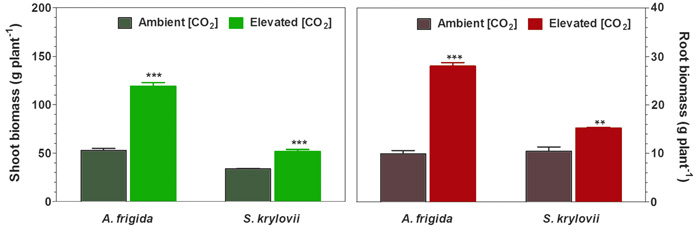| Follow @co2science |
Paper Reviewed
Liu, N., Tian, Q. and Zhang, W.-H. 2016. Artemisia frigida and Stipa krylovii, two dominant species in Inner Mongolia steppe, differed in their responses to elevated atmospheric CO2 concentration. Plant and Soil 409: 117-129.
Introducing their work, Liu et al. (2016) write that prior studies investigating the impacts of elevated CO2 on grassland species have mainly focused on the interaction between CO2 and water regimes. In contrast, they note that "few studies have explored the effects of elevated CO2 concentration on [the] growth of dominant grassland species by taking into account mineral nutrient availability in soils in general and phosphorus availability in particular."
Attempting to help remedy this data void, the three Chinese researchers set out to investigate the effects of elevated CO2 on the growth and acquisition of phosphorus of two dominant species from the Inner Mongolian steppe. This was accomplished by growing 30-day-old prairie sagewort (Artemisia frigida) and needlegrass (Stipa krylovii) in open-top chambers filled with native soils collected from a phosphorus-poor Inner Mongolia grassland at either ambient (383 ppm) or elevated (769 ppm) CO2 concentrations over a period of seven weeks. And what did their experiment reveal?
As shown in the figure below, the near-doubling of atmospheric CO2 stimulated the shoot and root biomass of needlegrass by 53 and 46 percent, respectively, whereas an even greater response was observed for prairie sagewort; shoot biomass of A. frigida increased by 125 percent and root biomass by 186 percent! In addition, Liu et al. report that elevated CO2 increased the primary root length, adventitious root number, root surface area and total root length in both plants, though the increases were not statistically significant for S. krylovii.

Figure 1. Effects of elevated CO2 on the shoot (left panel) and root (right panel) biomass of A. frigida and S. krylovii after 7 weeks of atmospheric CO2 enrichment. Adapted from Liu et al. (2016).
With respect to phosphorus (P) acquisition, the three Chinese researchers determined that elevated CO2 increased P accumulation, P acquisition efficiency, and P utilization efficiency by 59, 60 and 54 percent, respectively, in prairie sagewort, and by 50, 83 and 11 percent, respectively, in needlegrass.
The above findings would thus appear to foretell good fortunes for both of these grassland species growing on phosphorus-deficient soils in Inner Mongolia in the years and decades to come, courtesy of rising atmospheric CO2.
Posted 3 February 2017



